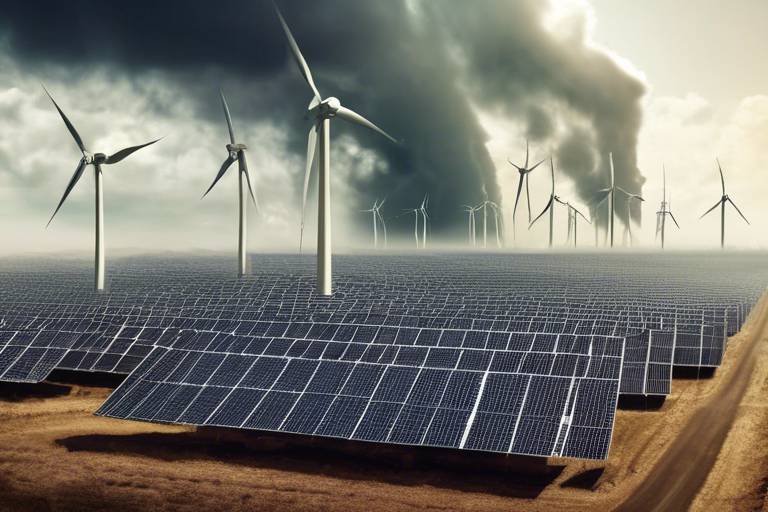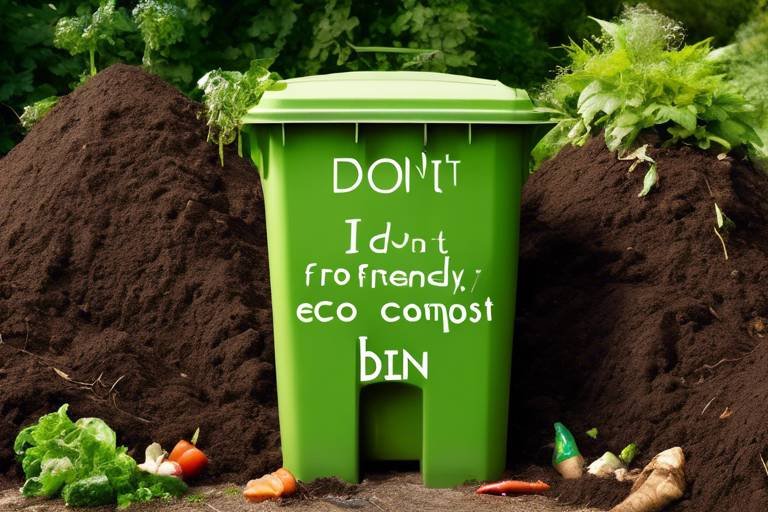10 Tips for Eco-Friendly Home Improvements
Are you looking to make your home more eco-friendly? Here are 10 practical tips for eco-friendly home improvements that will not only reduce your carbon footprint but also create a healthier living space for you and your family.
First and foremost, consider upgrading to energy-efficient lighting. By switching to LED bulbs or installing smart lighting systems, you can significantly reduce your energy consumption and lower your electricity bills. Not only will you be saving money, but you'll also be brightening your home with eco-friendly lighting solutions.
Another great way to make your home more sustainable is by investing in solar panel installation. By harnessing the power of the sun, you can generate clean and renewable energy, reducing your reliance on fossil fuels and decreasing your carbon emissions.
When it comes to water conservation, implementing water-saving fixtures like low-flow toilets and faucets, as well as rainwater harvesting systems, can help reduce water waste and promote sustainable water usage in your household.
Enhance your home's energy efficiency by focusing on insulation and weatherization. Properly insulating walls, floors, and attics, as well as sealing gaps and leaks, will help maintain a comfortable indoor temperature and lower heating and cooling costs.
Establishing a recycling and composting system in your home is essential for diverting waste from landfills, reducing greenhouse gas emissions, and creating nutrient-rich soil for your garden. This supports a circular economy and promotes sustainability.
Consider integrating greenery into your home with a green roof or living wall. Not only will this improve air quality and regulate indoor temperature, but it will also enhance biodiversity and add a touch of nature to your living space.
Upgrading to energy-efficient appliances is another effective way to reduce your environmental impact. By choosing ENERGY STAR certified appliances that consume less energy and water, you can promote sustainability while enjoying the latest technology and convenience in your home.
Opt for natural and non-toxic materials when making home improvements. Materials like bamboo flooring, reclaimed wood, and low-VOC paints can help create a healthy indoor environment free from harmful chemicals and pollutants, enhancing your well-being and sustainability efforts.
By implementing these 10 tips for eco-friendly home improvements, you can make a significant impact on the environment while creating a more sustainable and healthy living space for you and your loved ones.

Energy-Efficient Lighting
When it comes to creating an eco-friendly home, one of the key areas to focus on is . By making simple changes to your lighting setup, you can significantly reduce your energy consumption and contribute to a more sustainable living environment. One effective way to achieve this is by upgrading to LED bulbs. These bulbs use less energy than traditional incandescent bulbs and have a longer lifespan, saving you money on electricity bills in the long run.
Another option to consider is installing smart lighting systems. These systems allow you to control your lights remotely and set schedules to optimize energy usage. By automating your lighting, you can ensure that lights are only on when needed, further reducing energy waste. Not only does this benefit the environment, but it also enhances the convenience and comfort of your home.
By embracing energy-efficient lighting solutions, you not only lower your carbon footprint but also create a brighter and more sustainable living space for you and your family. With the advancements in technology and the wide range of options available, making the switch to eco-friendly lighting has never been easier or more rewarding.

Solar Panel Installation
Solar panel installation is a significant step towards embracing sustainable living and reducing your carbon footprint. By harnessing the sun's energy, you can power your home with clean and renewable electricity, contributing to a greener environment while also saving on energy costs in the long run.
When considering solar panel installation, it's essential to assess your home's suitability for solar energy generation. Factors such as the orientation and angle of your roof, shading from nearby trees or buildings, and local weather conditions can impact the efficiency of your solar panels.
Consulting with a professional solar panel installer can help you determine the optimal placement and size of the solar array for your specific needs. They can also advise you on available incentives, such as tax credits or rebates, that can make solar panel installation more affordable.
Additionally, investing in energy storage solutions, such as solar batteries, can further enhance the benefits of your solar panel system. By storing excess energy generated during the day, you can use it during peak hours or at night, increasing your energy independence and resilience.
Furthermore, regular maintenance and monitoring of your solar panels are crucial to ensure optimal performance and longevity. Cleaning the panels periodically and checking for any damage or malfunctions can help maximize energy production and prolong the lifespan of your solar energy system.
Overall, solar panel installation is a sustainable and cost-effective way to power your home while reducing your environmental impact. With advancements in solar technology and increasing accessibility, more homeowners are embracing solar energy as a clean and renewable alternative to traditional electricity sources.

Water Conservation
Water conservation is a vital aspect of creating an eco-friendly home. By implementing water-saving fixtures such as low-flow toilets and faucets, you can significantly reduce water waste in your household. These fixtures are designed to minimize water usage without compromising on performance, allowing you to contribute to sustainable water management.
In addition to installing water-saving fixtures, consider incorporating a rainwater harvesting system into your home. This system collects rainwater from your roof and stores it for later use in activities such as watering your garden or cleaning outdoor spaces. By utilizing rainwater, you can reduce your reliance on treated water from the municipal supply, conserving this valuable resource.
Another effective way to promote water conservation is by being mindful of your daily habits. Simple actions like turning off the tap while brushing your teeth, fixing leaks promptly, and only running the dishwasher or washing machine with full loads can make a significant difference in reducing water consumption. These small changes, when practiced consistently, can lead to substantial water savings over time.
Furthermore, consider landscaping your outdoor space with drought-resistant plants that require minimal watering. These plants are well-adapted to arid conditions and can thrive with little irrigation, helping you conserve water while maintaining a beautiful garden. Additionally, mulching around plants and trees can help retain soil moisture, reducing the need for frequent watering.
When it comes to water conservation, every drop counts. By implementing these strategies and making conscious choices to reduce water usage in your home, you can contribute to a more sustainable future while lowering your water bills and preserving this precious resource for generations to come.

Insulation and Weatherization
Discover how to make sustainable changes to your home with these practical and environmentally friendly tips for reducing your carbon footprint and creating a healthier living space.
When it comes to creating an eco-friendly home, insulation and weatherization play a crucial role in improving energy efficiency and reducing utility costs. By properly insulating walls, floors, and attics, you can prevent heat loss during the winter and keep your home cool in the summer. Additionally, sealing gaps and leaks helps maintain a consistent indoor temperature, reducing the need for excessive heating or cooling.
Consider using eco-friendly insulation materials such as recycled denim, wool, or cellulose, which not only provide excellent thermal performance but also have minimal impact on the environment. These materials are often made from recycled or renewable sources, making them a sustainable choice for your home.
Furthermore, weatherizing your home involves sealing air leaks around windows, doors, and ductwork to prevent drafts and improve overall comfort. By taking these simple yet effective steps, you can significantly reduce energy consumption, lower your carbon footprint, and create a more environmentally conscious living space.
Investing in proper insulation and weatherization not only benefits the environment but also enhances the comfort and value of your home. By improving energy efficiency, you can enjoy a more sustainable lifestyle while saving money on utility bills in the long run.
1. How can I determine if my home needs additional insulation?
2. What are the benefits of weatherizing my home?
3. Are there any eco-friendly insulation options available?
4. How can I find a professional to assess and improve my home's insulation and weatherization?

Recycling and Composting
Discover how to make sustainable changes to your home with these practical and environmentally friendly tips for reducing your carbon footprint and creating a healthier living space.
When it comes to reducing waste and promoting sustainability in your home, recycling and composting play a crucial role. By establishing a recycling system, you can divert materials like paper, plastic, glass, and metal from ending up in landfills, where they contribute to environmental pollution and greenhouse gas emissions. Recycling these items not only conserves natural resources but also saves energy that would be required to produce new products from raw materials.
Composting, on the other hand, allows you to turn organic waste such as food scraps, yard trimmings, and coffee grounds into nutrient-rich soil for your garden. This not only reduces the amount of waste sent to landfills but also creates a sustainable way to nourish your plants without relying on chemical fertilizers. Composting is like nature's recycling system, where organic matter is broken down into valuable nutrients that enrich the soil and support plant growth.
By incorporating both recycling and composting into your daily routine, you can actively contribute to a circular economy where resources are reused and regenerated, minimizing waste and environmental impact. These simple yet effective practices not only benefit the planet but also inspire others to adopt eco-friendly habits in their own homes.
1. How can I start recycling at home?
To start recycling at home, begin by setting up designated bins for different types of recyclable materials such as paper, plastic, glass, and metal. Educate yourself on what items can be recycled in your area and follow the guidelines provided by your local recycling program. Remember to rinse containers before recycling to avoid contamination.
2. What are the benefits of composting?
Composting has numerous benefits, including reducing waste sent to landfills, enriching soil with essential nutrients, and promoting healthier plant growth. It also helps to reduce greenhouse gas emissions associated with organic waste decomposition in landfills and minimizes the need for chemical fertilizers.
3. Can I compost in an apartment or small space?
Yes, you can compost in an apartment or small space using methods like vermicomposting (composting with worms), bokashi composting (fermentation process), or composting with a specialized indoor compost bin. These compact composting solutions are ideal for urban dwellers or those with limited outdoor space.

Green Roof or Living Wall
When it comes to creating a harmonious blend of nature and architecture in your home, opting for a can be a game-changer. Imagine a lush garden blooming on your rooftop or a vertical wall covered in vibrant plants, not only adding aesthetic appeal but also offering numerous environmental benefits.
Green roofs, also known as eco-roofs or vegetated roofs, involve covering the top of a building with vegetation, creating a natural insulating layer that helps regulate indoor temperatures. This not only reduces the need for artificial heating and cooling but also improves air quality by absorbing pollutants and carbon dioxide while releasing oxygen.
On the other hand, living walls are vertical gardens that can be installed both indoors and outdoors, providing a visually stunning display of plant life while purifying the air and reducing noise levels. These green installations act as natural air filters, trapping dust particles and pollutants, thus contributing to a healthier living environment.
Moreover, green roofs and living walls promote biodiversity by creating habitats for insects, birds, and other wildlife, fostering a mini ecosystem within your home. They also help manage stormwater runoff by absorbing rainwater, reducing the strain on drainage systems and preventing soil erosion.
Whether you choose to transform your roof into a flourishing garden retreat or adorn your walls with a living tapestry of plants, incorporating green elements into your home not only enhances its visual appeal but also demonstrates your commitment to sustainability and environmental stewardship.

Energy-Efficient Appliances
When it comes to making eco-friendly home improvements, one essential aspect to consider is upgrading to . By investing in ENERGY STAR certified appliances, you not only reduce your energy and water consumption but also contribute to sustainability efforts and minimize your environmental impact. These appliances are designed to operate more efficiently, helping you save on utility bills while enjoying the latest technology and convenience in your home.
Switching to energy-efficient appliances such as refrigerators, washing machines, dishwashers, and air conditioners can significantly decrease your household's energy usage. These appliances are engineered to consume less electricity and water without compromising on performance, making them a smart choice for environmentally conscious homeowners looking to reduce their carbon footprint.
Moreover, energy-efficient appliances not only benefit the environment but also enhance your overall living experience. With advanced features and innovative designs, these appliances offer improved functionality and durability, ensuring long-term savings and satisfaction. Whether you're renovating your kitchen or upgrading your laundry room, choosing energy-efficient appliances is a sustainable decision that aligns with your eco-friendly goals.

Natural and Non-Toxic Materials
When it comes to creating an eco-friendly home, choosing natural and non-toxic materials is key to promoting a healthy living environment for you and your family. Opting for sustainable building materials not only reduces your carbon footprint but also minimizes exposure to harmful chemicals commonly found in traditional construction materials.
One excellent choice for eco-conscious homeowners is bamboo flooring, known for its sustainability and durability. Bamboo grows rapidly, making it a renewable resource that can be harvested without causing harm to the environment. Additionally, bamboo flooring adds a touch of elegance to your home while contributing to a greener planet.
Another eco-friendly option is reclaimed wood, which gives a unique and rustic look to your home while reducing the demand for new timber. By repurposing old wood from sources like barns, warehouses, or old furniture, you not only prevent valuable resources from going to waste but also add character and charm to your living space.
When it comes to painting your home, choosing low-VOC (volatile organic compound) paints is essential for maintaining indoor air quality. Traditional paints release harmful chemicals into the air, contributing to health issues and air pollution. Opting for low-VOC paints reduces these risks, creating a safer and healthier environment for you and your loved ones.
By incorporating natural and non-toxic materials into your home, you not only support sustainable practices but also prioritize the well-being of your family and the planet. Making conscious choices in the materials you use can have a lasting impact on both your immediate surroundings and the environment as a whole.
Frequently Asked Questions
- What are the benefits of using energy-efficient lighting in my home?
Energy-efficient lighting, such as LED bulbs or smart lighting systems, can help reduce energy consumption, lower electricity bills, and provide a brighter and more eco-friendly lighting solution for your home.
- How do solar panels contribute to sustainable living?
Solar panels harness the sun's energy to generate clean and renewable electricity, reducing reliance on fossil fuels, lowering carbon emissions, and promoting a more sustainable and environmentally friendly lifestyle.
- Why is water conservation important for eco-friendly living?
Water conservation helps reduce water waste, promotes sustainable water usage, and supports environmental efforts to preserve this precious resource for future generations.
- What are the benefits of recycling and composting at home?
Recycling and composting help divert waste from landfills, reduce greenhouse gas emissions, and create nutrient-rich soil for gardening, contributing to a circular economy and a healthier environment.
- How do energy-efficient appliances contribute to sustainability?
ENERGY STAR certified appliances consume less energy and water, promoting sustainability, reducing environmental impact, and offering modern technology and convenience for your home.



















